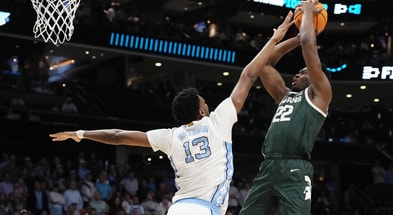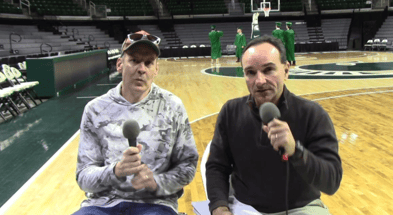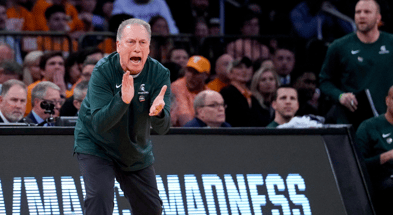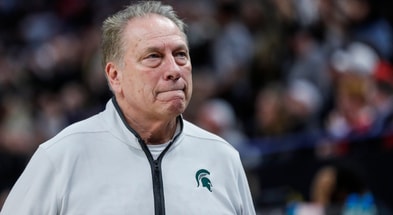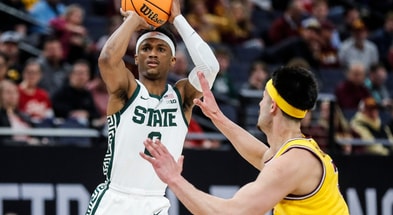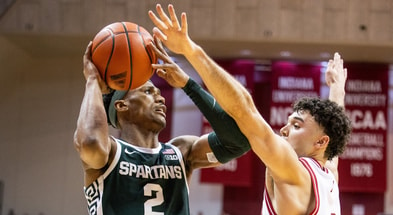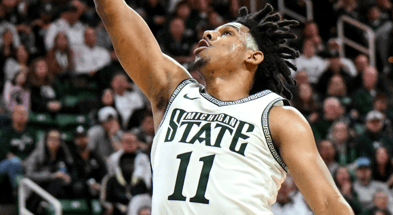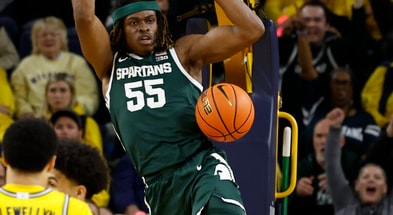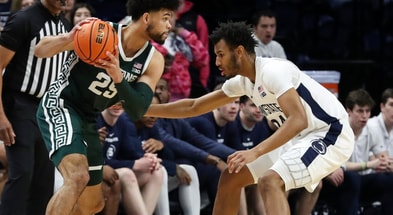The 3-2-1: Michigan State women's team trending toward NCAA Tournament bid
East Lansing, Mich. – For the first time all season, the Michigan State women’s basketball team faced adversity with it’s first back-to-back losing skid of the year when the Spartans fell to No. 13 Indiana on the road and No. 5 Ohio State at home. But the Spartans were able to recharge with a hard-earned 70-66 road win at Michigan on Sunday to sweep the season series with the Wolverines for the first time since 2019.
The loss to Ohio State ended a tough three-day stint in which the Spartans (18-7, 8-6 Big Ten) played three games in seven days from Feb. 5-11. That stretch which included matchups against two of the Big Ten’s top three teams would have been tough on anyone, but with a rotation of just seven players, fatigue may have played a role in Michigan State’s losses, especially the 15-point loss to the Buckeyes, which first-year head coach Robyn Fralick called a “stinker,” a description she had not used about her team’s play all season.
The Spartans will look to continue their winning ways when they head to Purdue for a 7 p.m. showdown with the Boilermakers on Wednesday (BTN+).
Continue below for Three Things We’ve Learned, Two Questions and One Prediction as the Spartans get set for their final four regular season games.
THREE THINGS WE LEARNED
1. THIS TEAM COULD BE FOLLOWING IN FAMOUS FOOTSTEPS
You may think Michigan State’s charge to an increasingly-likely NCAA Tournament bid despite a depleted roster bitten by injury is a bit of a surprise, but it’s not the first time a Spartan team has made a similar run. In the 2002-03 season, Michigan State made the NCAA Tournament with a 17-11 record and a roster that featured just seven healthy bodies.
Now, granted that team was buoyed by some pretty talented former Spartans in Kristin Haynie, Lindsay Bowen, Liz Shimek and Kelli Roehrig but that group which also featured Julie Pagel and Syreeta Bromfield, played with an us-against-the-world mentality despite their youth and lack of depth before losing to TCU in the first round of the NCAAs at Storrs, Conn.
This year’s team, which is defined by the experience of having two graduate seniors in Moira Joiner and Julia Ayrault and one junior in DeeDee Hagemann, resembles that 2002-03 group in the fact that the lineup numbers are depleted but the quality of play is high in both execution, mentality and attitude.
Barring a shocking fall from grace, this team will make the Big Dance despite having just a seven-person rotation.
Also, as a point of reference, two years later, key members from that 2002-03 team played in the NCAA Championship game against Baylor.
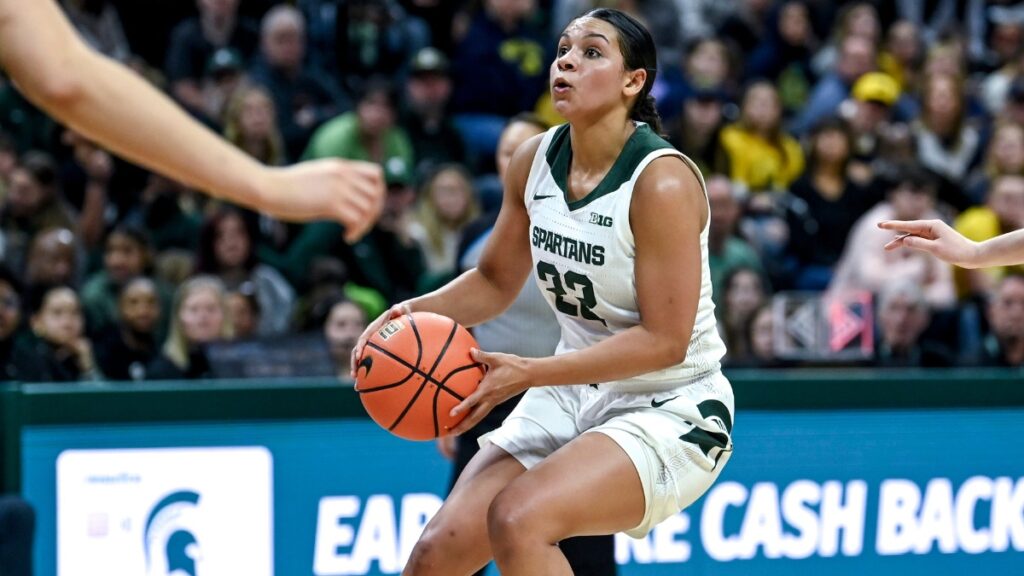
Senior guard Moira Joiner, from Saginaw, is Michigan State’s second-leading scorer at 14.6 points per game and is also the Spartans’ defensive stopper. (Photo by Nick King | USA Today Network).
2. MID-MAJOR RESOURCEFULNESS IS A PLUS
Here’s something to think about.
Fralick came from a mid-major program in Bowling Green, where many times, a team’s success is defined by its ability to play with a smaller lineup in terms of height and even in some cases a lack of depth on the bench.
Good mid-major squads usually play a defined inside-out game, where the drive-and-kick to the open shooter on the perimeter translates into success because your 5-foot-10 to 6-foot-1 players have the ability to rack up points on the perimeter without being limited in the post against taller teams.
Michigan State’s tallest player is Ayrault at 6-foot-2 and the Spartans, eventhough, they may be outrebounded in most games, are able to hold their own if their guards can contribute on the boards.
So the fact that Michigan State is lacking post size with the loss of 6-3 junior forward Isaline Alexander and 6-5 freshman center Mary Meng to season-ending injuries isn’t as much of a shock to the system as many might think.
As a matter of fact, the Spartans lack of height may be something that Fralick and her staff had an easier time adjusting to than most coaches who would be thrust into the situation Michigan State found itself in by midseason.
The Spartans’ lack of size will hamper this team’s chances of making a deep run in the postseason but its not stopping this group from getting there with an uptempo offense, good shooting, quickness and anticipation on defense, and timely use of the press, something that good mid-majors often do to sustain success.
After its win over Michigan on Sunday, Fralick gave us a peek inside the identity that has led to Michigan State’s trending success this season.
“You become what you talk about. You become what you preach, you become how you play, you become your habits. As a staff, what we try to do every day is be really clear about who we are and own it. Own what we’re good at and own who we are,’’ Fralick said. “The reality is, if you really want to be a good team, you have to be tough. You have to be resilient, and you have to be connected. You have peaks and valleys (but) you’ve got to find ways to stay together. So we’ll always stay in pursuit of those things.’’
3. SHARING IS CARING
In the Spartans two losses against Indiana and Ohio State there was something missing that cost them a chance to win both games – sharing the basketball.
One of the things that has defined this team’s success is the players’ ability to share the ball, which for this team means having the patience to make that extra pass that leads to an open opportunity to score.
Against the Hoosiers, Michigan State had just 14 assists on 33 made baskets. And against the Buckeyes, the Spartans compiled just 16 assists on 23 made baskets.
This team is at its best when it averages 20-25 assists per game. In wins against Minnesota and Rutgers prior to dropping back-to-back contests for the first time this season, Michigan State had 21 assists on 29 made baskets versus the Gophers and 22 assists on 33 made baskets against the Scarlet Knights.
TWO QUESTIONS
1. IS THIS TEAM IN DANGER OF MISSING THE BIG DANCE?
Not unless the Spartans suffer an injury to one of its top three scorers – Joiner, Ayrault or Hagemann – and go on an extended losing streak to close out the regular season. With four players down for the year due to injury, Michigan State has adjusted well with its seven-player rotation, led by the combined contributions of this trio which accounts for 42.6 of the team’s 85 points per game.
2. WILL THE LACK OF A QUALITY WIN AFFECT THE SPARTANS’ NCAA SEEDING?
It shouldn’t have much of an effect on the team’s seeding. The Spartans have been projected anywhere from a No. 7 to a No. 9 seed for much of the second half of the season. Unless Michigan State loses multiple games against the teams at the bottom of the standings, don’t expect things to change much in terms of seed projections. However, with a strong finish and a good showing in the Big Ten Tournament, the Spartans might even be able to earn a No. 6 seed.
Additionally, when you consider the fact that Michigan State’s losses to ranked conference teams have been by five points or less in three of the four contests means they are competitively viable against the top three schools in the Big Ten in Ohio State, Iowa and Indiana.
ONE PREDICTION
1. TWENTY WINS
Twenty wins and more. I’m penciling this squad in for 20-plus wins. With four games left against teams with losing Big Ten records there should be no reason this team can’t pick up at least three more wins before entering the Big Ten Tournament. The Spartans’ toughest matchup with five games remaining was against the Wolverines and they cleared that hurdle on Sunday.
Purdue, Rutgers, Illinois and Wisconsin have a combined Big Ten record of 17-40 after Sunday’s play.
The Big Ten Tournament starts on March 6 in Minneapolis and goes through March 10.



